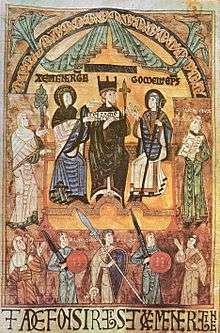Alfonso III of Asturias
| Alfonso III | |
|---|---|
 Miniature (c. 1118) from the archives of Oviedo Cathedral showing Alfonso III flanked by his queen, Jimena (left), and his bishop, Gomelo II (right). | |
| King of Asturias | |
| Reign | 866–910 |
| Predecessor | Ordoño I |
| Successor |
Fruela II (Asturias) García I (León) Ordoño II (Galicia) |
| Born | c. 848 |
| Died | 20 December 910 |
| Burial | Cathedral of San Salvador, Oviedo |
| Consort | Jimena of Pamplona |
| Issue |
Fruela II of León García I of León Ordoño II of León |
| Dynasty | Astur-Leonese dynasty |
| Father | Ordoño I of Asturias |
| Mother | Nuña |
| Religion | Roman Catholicism |
| Signature |
 |
Alfonso III (c. 848 – 20 December 910), called the Great (Spanish: el Magno), was the king of León, Galicia and Asturias from 866 until his death. He was the son and successor of Ordoño I. In later sources he is the earliest to be called "Emperor of Spain." He was also titled "Prince of all Galicia" (Princeps totius Galletiae[1]).
Life
Alfonso's reign was notable for his comparative success in consolidating the kingdom during the weakness of the Umayyad princes of Córdoba. He fought against and gained numerous victories over the Muslims of al-Andalus.[2]
During the first year of his reign, he had to contend with a usurper, Count Fruela of Galicia. He was forced flee to Castile, but after a few months Fruela was assassinated and Alfonso returned to Oviedo.
He defeated a Basque rebellion in 867 and, much later, a Galician one as well. He conquered Oporto and Coimbra in 868 and 878 respectively. In about 869, he formed an alliance with the Kingdom of Pamplona, and solidified this link by marrying Jimena, who is thought to have been daughter of king García Íñiguez, or less likely, a member of the Jiménez dynasty, and also married his sister Leodegundia to a prince of Pamplona.
He ordered the creation of three chronicles which presented the theory that the kingdom of Asturias was the rightful successor of the old Visigothic kingdom. He was also a patron of the arts, like his grandfather before him. He built the church of Santo Adriano de Tuñón. According to a letter of disputed authenticity dated to 906, the Epistola Adefonsi Hispaniae regis, Alfonso arranged to purchase an "imperial crown" from the cathedral of Tours.[3]
In 909, Alfonso relocated the seat of his government to Oviedo. According to Sampiro, his sons (García, Ordoño, Gonzalo, Fruela and Ramiro) conspired against him, under the influence of García's father-in-law. Alfonso had García imprisoned but they were able to eject him and he fled to Boiges. However, he returned and convinced García to join him in a campaign against the Moors. Alfonso died in Zamora of natural causes in 910, having reigned for 44 years. Ibn Hayyan likewise tells of an uprising, but says that Alfonso himself had been imprisoned. Following his death there was a partition of his realm: his eldest son, García, became king of León. The second son, Ordoño, reigned in Galicia, while Fruela, received Asturias with Oviedo as his capital. These lands would be reunited when García died childless and León passed to Ordoño, while on his death the lands were reunited under Fruela. However, Fruela's death the next year initiated a series of internecine struggles that led to unstable succession for over a century.
References
| Wikimedia Commons has media related to Alfonso III of Asturias. |
- ↑ España Sagrada. Memorias de los insignes monasterios de San Julián de Samos, y San Vicente de Monforte.
- ↑

- ↑ R. A. Fletcher, Saint James's Catapult: The Life and Times of Diego Gelmírez of Santiago de Compostela (Oxford, 1984), 317–23.
| Preceded by Ordoño I |
King of Asturias 866–910 |
Succeeded by Fruela II |
| King of León 866–910 |
Succeeded by García I | |
| New title | King of Galicia | Succeeded by Ordoño II |